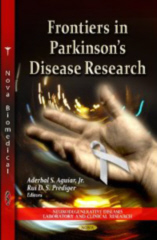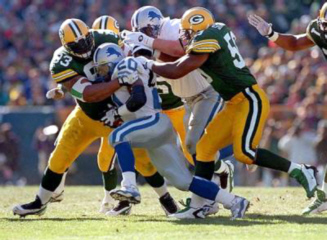������������������ ������������������������������������������������������������������������������������������������������������������������������
27th September 2012 - New
research
THE CLINICAL FEATURES OF VASCULAR PARKINSONISM
Journal of Neurology, Neurosurgery and Psychiatry [2012] 83 (10) : 1027-1029
(Glass PG, Lees AJ, Bacellar A, Zijlmans J, Katzenschlager R, Silveira-Moriyama
L.)
Complete abstract
Vascular Parkinsonism is produced by strokes
that affect the basal ganglia in the brain. A
stroke is the loss of activity of a discreet area of the brain because of
blockage of the blood supply to that brain region.
Researchers evaluated in detail the clinical features in confirmed cases of
Vascular Parkinsonism. Those assessed in the study had an average age of onset
at 70 years old, and had Parkinson's Disease for an average of just over 10
years.�
 Bradykinesia
(slow movement) was present in everybody who had Vascular Parkinsonism.
Rigidity was present in almost everybody (96% of cases). Falls were present in
76%, pyramidal signs in 54%, urinary incontinence in 50% and dementia in 39%.
None of them had visual hallucinations. Two thirds of them developed Vascular
Parkinsonism in
a seemingly
harmless
way but actually with
grave effects. The progression of the disability was then relentless. People with
Vascular Parkinsonism had an older age of onset than those people who had
Parkinson's Disease. This pattern of symptoms might help distinguish Vascular
Parkinsonism from Parkinson's Disease.
For a printable version of this article
click here.�
In order to refer to this article on its own
click here
Bradykinesia
(slow movement) was present in everybody who had Vascular Parkinsonism.
Rigidity was present in almost everybody (96% of cases). Falls were present in
76%, pyramidal signs in 54%, urinary incontinence in 50% and dementia in 39%.
None of them had visual hallucinations. Two thirds of them developed Vascular
Parkinsonism in
a seemingly
harmless
way but actually with
grave effects. The progression of the disability was then relentless. People with
Vascular Parkinsonism had an older age of onset than those people who had
Parkinson's Disease. This pattern of symptoms might help distinguish Vascular
Parkinsonism from Parkinson's Disease.
For a printable version of this article
click here.�
In order to refer to this article on its own
click here
�
23rd September 2012 - New book
FRONTIERS IN PARKINSON'S DISEASE RESEARCH
Aderbal S. (Author, Editor), Jr. Aguiar (Author,
Editor), Rui D. S. Prediger (Editor)
 Publisher's
description : Parkinson's disease is a neurodegenerative disorder that
affects approximately 1 million persons in the United States. This disease has
been a force in the transformation of neurology from a specialty restricted to
diagnosis into one with active and controversial therapies. This book is an
up-to-date volume presenting hot topics in this actual scenario. Sections
include new functional aspects of basal ganglia, little-known environmental
factors in the aetiology of the disease, insights into the disease-related
neurodegeneration, a critical discussion of current treatments and their
limitations, and unexplored neuropsychiatric presentations of the disease.
Click
here for more details. For
more books concerning Parkinson's Disease go to
Parkinson's Disease Books.
Publisher's
description : Parkinson's disease is a neurodegenerative disorder that
affects approximately 1 million persons in the United States. This disease has
been a force in the transformation of neurology from a specialty restricted to
diagnosis into one with active and controversial therapies. This book is an
up-to-date volume presenting hot topics in this actual scenario. Sections
include new functional aspects of basal ganglia, little-known environmental
factors in the aetiology of the disease, insights into the disease-related
neurodegeneration, a critical discussion of current treatments and their
limitations, and unexplored neuropsychiatric presentations of the disease.
Click
here for more details. For
more books concerning Parkinson's Disease go to
Parkinson's Disease Books.
�
13th September 2012 - New
research
HIGH PREVALENCE OF
PARKINSON'S DISEASE IN CANADA
Parkinsonism Related Disorders [2012] 18 (4) : 327-331 (Allyson Jones C, Wayne
Martin WR, Wieler M, King-Jesso P, Voaklander DC.)
Complete abstract
The prevalence of Parkinson's Disease in Canada has been found to be one of the
highest of any country in the world. The study was carried out in British
Columbia, Canada. The prevalence rates amongst men were found to be 396-207 per
100,000 for men, and 259 to 127 per 100,000 for women. Combining the figures for
both men and women gives figures of around 317 to 167 per 100,00.
 These
figures are just about higher than those in the U.S.A., which has one of the
highest prevalence rates of any country. The only countries with higher
prevalence rates than Canada are Albania and Egypt, where the prevalence rates
are exceptionally high. The ratio of men to women with Parkinson's Disease in
Canada is 1.56. As in most countries in the world, in Canada there are more men
than women with Parkinson's Disease. For more concerning prevalence
go to the
Prevalence of Parkinson's Disease. For a
printable version of this article
click here.�
In order to refer to this article on its own
click here.�
These
figures are just about higher than those in the U.S.A., which has one of the
highest prevalence rates of any country. The only countries with higher
prevalence rates than Canada are Albania and Egypt, where the prevalence rates
are exceptionally high. The ratio of men to women with Parkinson's Disease in
Canada is 1.56. As in most countries in the world, in Canada there are more men
than women with Parkinson's Disease. For more concerning prevalence
go to the
Prevalence of Parkinson's Disease. For a
printable version of this article
click here.�
In order to refer to this article on its own
click here.�
�
9th September 2012 - New research
THE SAFETY AND TOLERABILITY OF NEUPRO
Parkinsonism Related Disorders [2012] Sep 3 [Epub ahead of print] (Oertel W,
Lewitt P, Giladi N, Ghys L, Grieger F, Boroojerdi B.)
Complete abstract
Although dopamine agonists are sometimes perceived as poorly tolerated by the
elderly, there is little clinical evidence to support these concerns. So the
safety and tolerability of rotigotine transdermal system have been assessed in
four 6-month studies. : two in early Parkinson's Disease and two in advanced
Parkinson's Disease.
Neupro� (Rotigotine Transdermal System) is a
dopamine agonist that is applied to the skin in order to continuously deliver
rotigotine over a 24-hour period.
For more information go to
Neupro.
 For
most adverse events no age-related differences in were observed. In early
Parkinson's Disease those symptoms more common in those younger than 65 in
comparison to those who were 65 were : nausea (38% v 30%) and headache (15% v
9%). In another study, amongst older patients, those symptoms more common in
those younger than 75 in comparison to those who were 75 were : nausea (36% v
21%), and dizziness (15% v 28%). In people with advanced Parkinson's Disease it
was still the younger patients that more commonly had nausea (24% v 19%). Only falls that were more common in older patients (13% v 8%). So oddly, the
adverse events of this dopamine agonists were generally less rather than greater with age,
as if the adverse events were adapted to. For a printable version of this article
click here.�
In order to refer to this article on its own
click here.�
For
most adverse events no age-related differences in were observed. In early
Parkinson's Disease those symptoms more common in those younger than 65 in
comparison to those who were 65 were : nausea (38% v 30%) and headache (15% v
9%). In another study, amongst older patients, those symptoms more common in
those younger than 75 in comparison to those who were 75 were : nausea (36% v
21%), and dizziness (15% v 28%). In people with advanced Parkinson's Disease it
was still the younger patients that more commonly had nausea (24% v 19%). Only falls that were more common in older patients (13% v 8%). So oddly, the
adverse events of this dopamine agonists were generally less rather than greater with age,
as if the adverse events were adapted to. For a printable version of this article
click here.�
In order to refer to this article on its own
click here.�
�
8th September 2012 - New research
NFL PLAYERS TREBLE THE RISK OF PARKINSON'S DISEASE
Neurology [2012] Sep 5 [Epub ahead of print]
(Lehman EJ, Hein MJ, Baron SL, Gersic CM.)
Complete abstract
 Players
in the NFL ("American" Football's National Football
League) were found to have treble the risk of haiving a neurodegenerative
disease generally. This included Parkinson's Disease, Alzheimer's Disease and
ALS. The figures for Alzheimer's Disease were more than three times more likely,
and the figures for ALS were more than four times more likely. The likelihood of
developing Parkinson's Disease was less. Research suggests that concussions and repeated blows to the head are likely to
blame for the increased risk, but the researcher says multiple studies are
needed in order to blame concussions. For a printable version of this article
click here.�
In order to refer to this article on its own
click here.�
Players
in the NFL ("American" Football's National Football
League) were found to have treble the risk of haiving a neurodegenerative
disease generally. This included Parkinson's Disease, Alzheimer's Disease and
ALS. The figures for Alzheimer's Disease were more than three times more likely,
and the figures for ALS were more than four times more likely. The likelihood of
developing Parkinson's Disease was less. Research suggests that concussions and repeated blows to the head are likely to
blame for the increased risk, but the researcher says multiple studies are
needed in order to blame concussions. For a printable version of this article
click here.�
In order to refer to this article on its own
click here.�
.gif)
.gif)
 Bradykinesia
(slow movement) was present in everybody who had Vascular Parkinsonism.
Rigidity was present in almost everybody (96% of cases). Falls were present in
76%, pyramidal signs in 54%, urinary incontinence in 50% and dementia in 39%.
None of them had visual hallucinations. Two thirds of them developed Vascular
Parkinsonism in
Bradykinesia
(slow movement) was present in everybody who had Vascular Parkinsonism.
Rigidity was present in almost everybody (96% of cases). Falls were present in
76%, pyramidal signs in 54%, urinary incontinence in 50% and dementia in 39%.
None of them had visual hallucinations. Two thirds of them developed Vascular
Parkinsonism in
 Publisher's
description : Parkinson's disease is a neurodegenerative disorder that
affects approximately 1 million persons in the United States. This disease has
been a force in the transformation of neurology from a specialty restricted to
diagnosis into one with active and controversial therapies. This book is an
up-to-date volume presenting hot topics in this actual scenario. Sections
include new functional aspects of basal ganglia, little-known environmental
factors in the aetiology of the disease, insights into the disease-related
neurodegeneration, a critical discussion of current treatments and their
limitations, and unexplored neuropsychiatric presentations of the disease.
Publisher's
description : Parkinson's disease is a neurodegenerative disorder that
affects approximately 1 million persons in the United States. This disease has
been a force in the transformation of neurology from a specialty restricted to
diagnosis into one with active and controversial therapies. This book is an
up-to-date volume presenting hot topics in this actual scenario. Sections
include new functional aspects of basal ganglia, little-known environmental
factors in the aetiology of the disease, insights into the disease-related
neurodegeneration, a critical discussion of current treatments and their
limitations, and unexplored neuropsychiatric presentations of the disease.
 These
figures are just about higher than those in the U.S.A., which has one of the
highest prevalence rates of any country. The only countries with higher
prevalence rates than Canada are Albania and Egypt, where the prevalence rates
are exceptionally high. The ratio of men to women with Parkinson's Disease in
Canada is 1.56. As in most countries in the world, in Canada there are more men
than women with Parkinson's Disease. For more concerning prevalence
go to the
These
figures are just about higher than those in the U.S.A., which has one of the
highest prevalence rates of any country. The only countries with higher
prevalence rates than Canada are Albania and Egypt, where the prevalence rates
are exceptionally high. The ratio of men to women with Parkinson's Disease in
Canada is 1.56. As in most countries in the world, in Canada there are more men
than women with Parkinson's Disease. For more concerning prevalence
go to the  For
most adverse events no age-related differences in were observed. In early
Parkinson's Disease those symptoms more common in those younger than 65 in
comparison to those who were 65 were : nausea (38% v 30%) and headache (15% v
9%). In another study, amongst older patients, those symptoms more common in
those younger than 75 in comparison to those who were 75 were : nausea (36% v
21%), and dizziness (15% v 28%). In people with advanced Parkinson's Disease it
was still the younger patients that more commonly had nausea (24% v 19%). Only falls that were more common in older patients (13% v 8%). So oddly, the
adverse events of this dopamine agonists were generally less rather than greater with age,
as if the adverse events were adapted to. For a printable version of this article
For
most adverse events no age-related differences in were observed. In early
Parkinson's Disease those symptoms more common in those younger than 65 in
comparison to those who were 65 were : nausea (38% v 30%) and headache (15% v
9%). In another study, amongst older patients, those symptoms more common in
those younger than 75 in comparison to those who were 75 were : nausea (36% v
21%), and dizziness (15% v 28%). In people with advanced Parkinson's Disease it
was still the younger patients that more commonly had nausea (24% v 19%). Only falls that were more common in older patients (13% v 8%). So oddly, the
adverse events of this dopamine agonists were generally less rather than greater with age,
as if the adverse events were adapted to. For a printable version of this article
 Players
in the NFL ("American" Football's National Football
League) were found to have treble the risk of haiving a neurodegenerative
disease generally. This included Parkinson's Disease, Alzheimer's Disease and
ALS. The figures for Alzheimer's Disease were more than three times more likely,
and the figures for ALS were more than four times more likely. The likelihood of
developing Parkinson's Disease was less. Research suggests that concussions and repeated blows to the head are likely to
blame for the increased risk, but the researcher says multiple studies are
needed in order to blame concussions. For a printable version of this article
Players
in the NFL ("American" Football's National Football
League) were found to have treble the risk of haiving a neurodegenerative
disease generally. This included Parkinson's Disease, Alzheimer's Disease and
ALS. The figures for Alzheimer's Disease were more than three times more likely,
and the figures for ALS were more than four times more likely. The likelihood of
developing Parkinson's Disease was less. Research suggests that concussions and repeated blows to the head are likely to
blame for the increased risk, but the researcher says multiple studies are
needed in order to blame concussions. For a printable version of this article